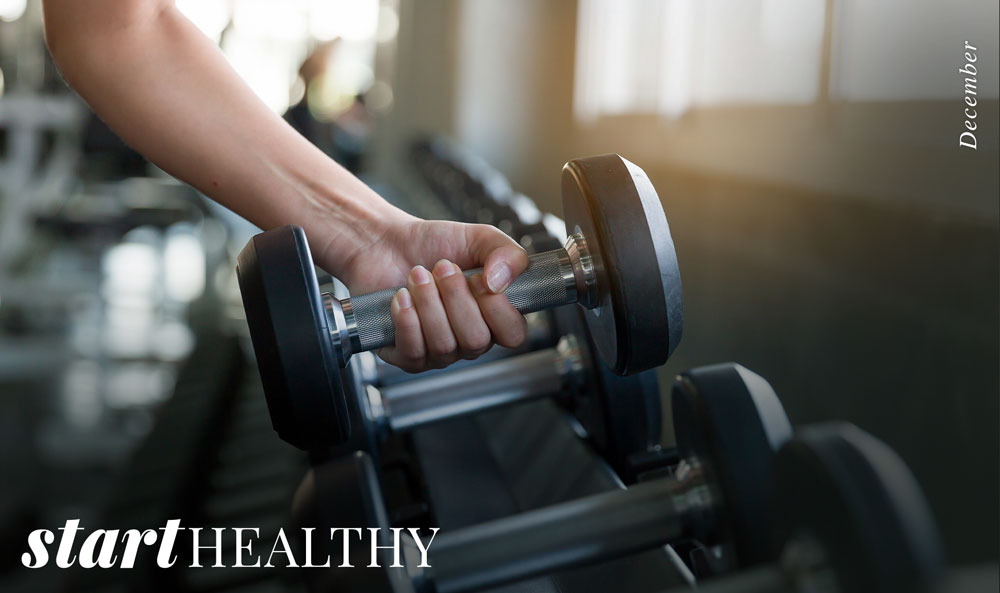December is a time to invigorate the senses and embrace the season with warmth, wellness, and joy. This edition of Start Healthy is bursting with ideas to help you have your best season yet while promoting your physical and mental well-being. Inside, you’ll find expert winter workout tips, a guide to getting glowing skin, delicious Mediterranean side dishes, and unique board game ideas to invigorate everyone.
As the cool breeze arrives and temperatures drop, staying motivated to exercise can feel like a daunting task. The enclosed interview with a pro trainer spills the secrets to staying fit and fired up even when the weather outside is frightful. His advice can help you find ways to make exercise a fun and rewarding experience, no matter the conditions.
The harsh winds and dry air of winter can wreak havoc on your skin, leaving it feeling dull and dehydrated. Discover essential tips and tricks, including advice on the best products to use and effective cleansing and moisturizing routines, that can make a big difference to your skin day in and day out.
As you prepare festive holiday meals, let the vibrant flavors of the Mediterranean transport everyone to a sun-drenched paradise. The crowd-pleasing recipes inside for paprika roast potatoes and celery avgolemono will leave your guests asking for seconds.
Gather your loved ones around the table for an evening of laughter, connection, and surprising mental stimulation. This issue's article on board games encourages you to rediscover the joy of this time-honored activity and reap the rewards of strengthened relationships, improved cognitive function, and a happier, healthier you.
Here’s to ending the year on a healthy and happy note! As always, it’s a pleasure to send you this magazine.
As chilly weather descends, you may find it more challenging to stay active. Matt Ryan, personal trainer and owner of Heavy Mettle Fitness in Austin, Texas, explains how you can maintain your wellness during these months.
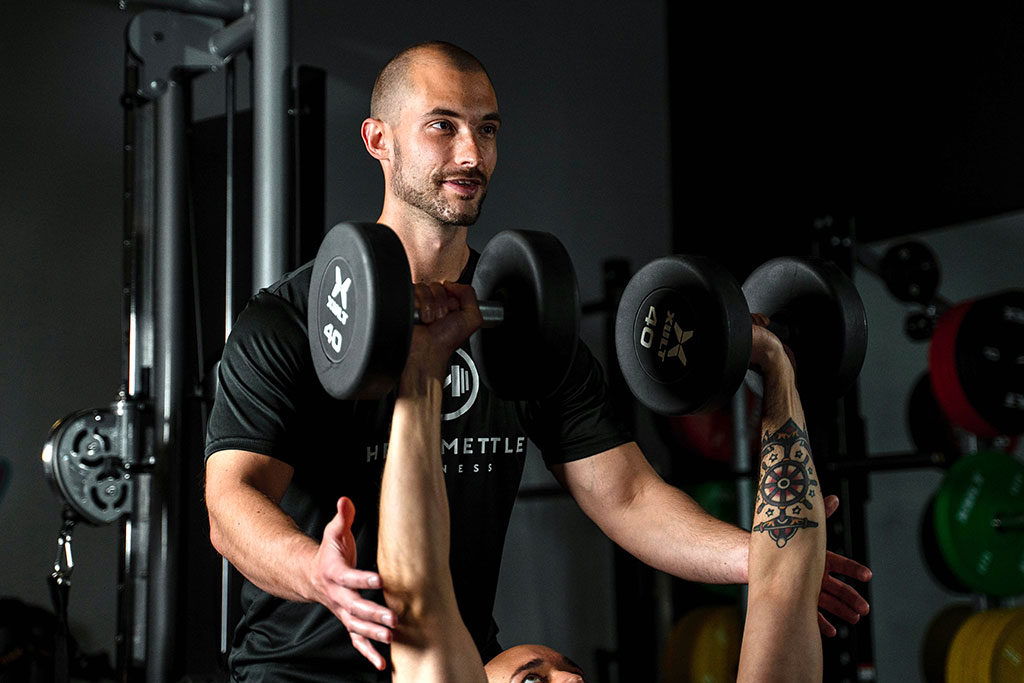
Would you describe your fitness training expertise?
My experience in the industry began at age nineteen when I started competing in natural bodybuilding competitions. I then launched Heavy Mettle Fitness in Austin, Texas, in 2019. As the fitness director and lead trainer, I am tasked with heading a team of expert personal trainers and offering exercise and nutrition services to our clients.
Our approach to training is mainly oriented around resistance exercises. But we personalize each client’s individual program to address their specific needs and goals and even provide them with a structured weekly workout routine they can implement outside our studio sessions.
How can someone determine the right fitness regimen for their body type and goals?
Start by assessing your current health and abilities along with your big-picture goals. From there, research which type of exercises will be most conducive to achieving them. For example, if someone wants to build muscle, lose fat, and improve their overall health, resistance training with weights would be ideal.

Why is it important to stay active in winter?
It’s actually important to stay active all year round. Going through cyclical periods of activity and nonactivity won’t help you achieve and sustain good health. Instead, you have to approach your fitness and nutrition regimen with the mindset of making it your lifestyle and not a short-term effort—like brushing your teeth regularly to maintain your dental hygiene. In other words, to be healthy, you have to live healthy.
Plus, achieving fitness goals simply takes time. So if you want, say, a toned physique for summer, working toward that in the wintertime will grant you a much higher probability of developing it versus starting on your six-pack four weeks before your beach vacation.
Why do many people struggle to stay motivated and active around the holidays?
I wouldn’t say people are less motivated to exercise this time of year, but I do think that added variables like travel and unpredictable schedules certainly complicate things. Outside factors that disrupt a routine can more easily disincentivize someone to adhere to their fitness and nutrition regimen. This is especially true for those who don’t like working out; very little can change that sentiment, but there’s a lot that can reinforce it.
That’s where a personal trainer comes in. We help those who lack the desire and drive to work out develop a plan that will enable them to stick to their routine—regardless of the circumstances.

How should people adjust their exercise regimen on cold days?
The exercises you do don’t need to be radically different from any other point of the year. But your body may take longer to warm up, so consider wearing warmer clothing during a workout, such as a hoodie with an athletic T-shirt underneath. Layered clothes will allow your body to reach and sustain a warmer temperature more efficiently, ensuring better blood flow to your joints and improving muscle activation. This will reduce your risk of injury and lead to a more effective workout.
You should also consider extending the duration of your warmup. For example, utilize bands for dynamic stretches or walk on a treadmill for ten to fifteen minutes before starting a weight training session. And remember that even though it may be colder outside, it is still essential to stay hydrated throughout your workout.
Another thing you can do to stay healthy throughout winter is maintain a high daily step count, which you can typically track on your smartphone. Keeping it elevated can help burn more calories and offset any lack of activity if you end up missing a workout due to bad weather or a busy schedule.
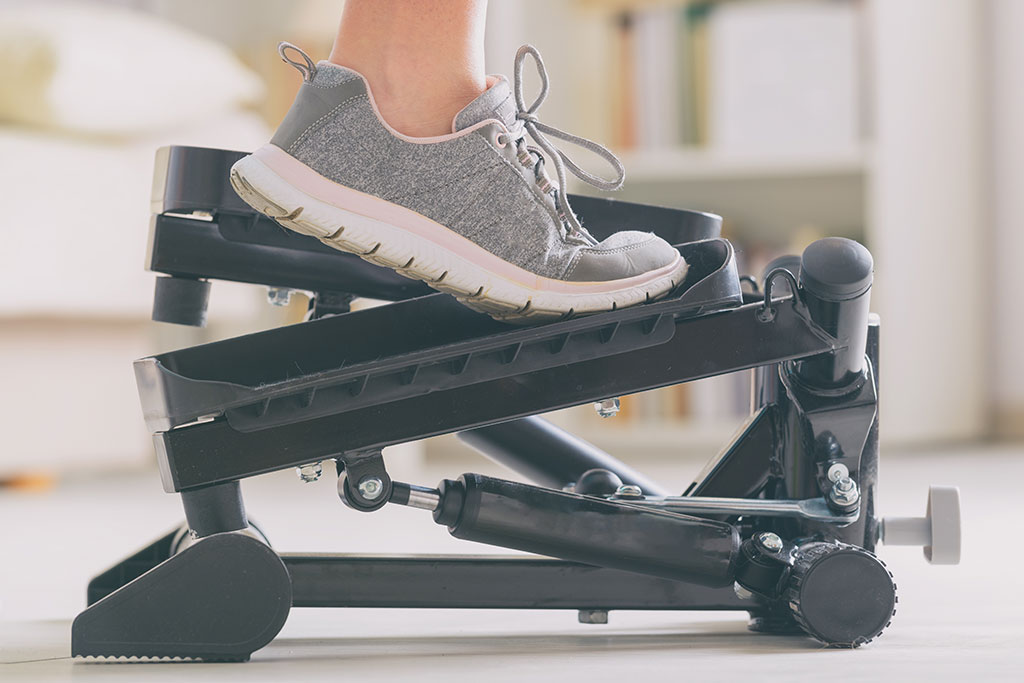
Holiday food can be a stumbling block for staying healthy. What advice do you have for this obstacle?
In addition to sustaining your normal fitness routine, be mindful of your food intake. This doesn’t mean that you can’t enjoy your holiday favorites; having a slice of pie won’t completely derail your progress. Just be sure to balance them with the appropriate nutrients. We encourage our clients to consider the portions of the foods they’re having at the dinner table. After all, caloric intake is the main factor that affects weight loss or gain.
How do you personally maintain your fitness on cold days?
My favorite form of cardio is taking my dog for long walks or runs. So when it’s cold outside, we both need to bundle up. And if the road surface is slick, we’ll elect to walk for a longer period rather than run to avoid slips and falls.
For more info, visit heavymettlefitness.com
The holidays are meant for celebration and family get-togethers, but this time of year isn’t all fun—between the crisp winter air, dry indoor heating, and stress of gift shopping, the skin on your face may become dull, dehydrated, or irritated. Here are some routines and products that can help you keep it healthy and radiant all season long.

The foundational first step of any effective skin-care regimen, cleansing gets rid of the daily dirt, oil, makeup, and sweat that builds up on your skin, which can, in turn, block your pores and cause breakouts. The key is to select a cleanser that fits your skin type.
For example, salicylic acid foaming cleansers can be a solution for oily complexions since they help to reduce shine and control surplus oil. Meanwhile, creamy cleansers featuring hyaluronic acid or rosehip seed oil, components known for their hydrating qualities, are good for dry skin. And to prevent aggravation of sensitive skin, a milky, fragrance-free mix is perfect.
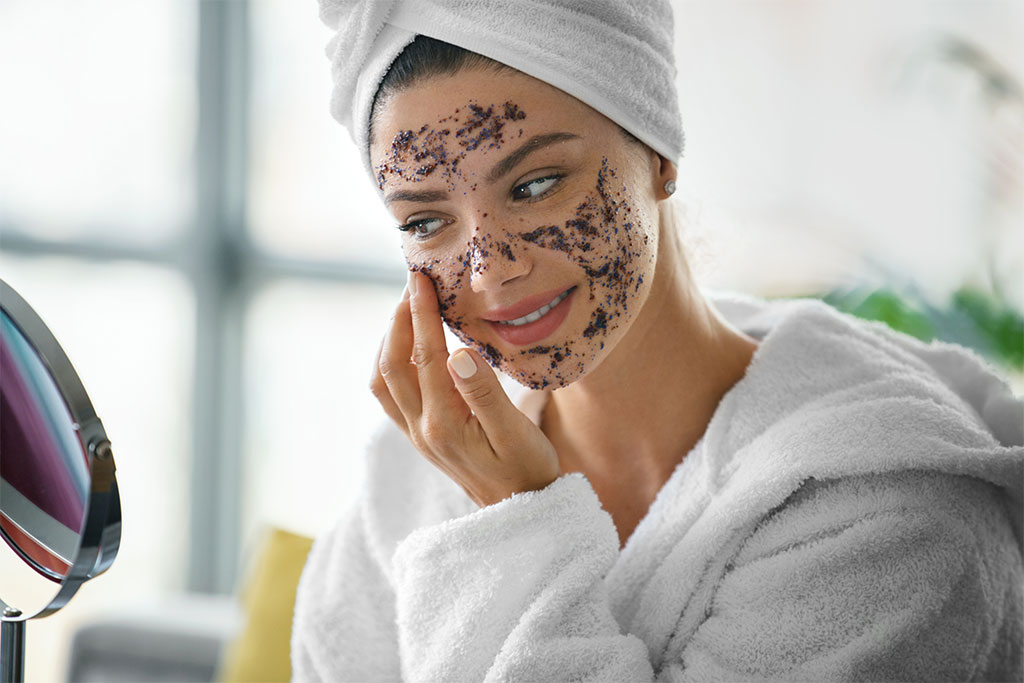
Even with enough hydration, dead skin cells can dull your complexion by gathering on the surface layer of your skin. Depending on how much your skin may shed, how oily it is, and how sensitive it may be, exfoliants can be an effective way to remove these cells, resulting in a more brilliant appearance. However, you should only exfoliate one to three times a week to avoid irritation, and be especially gentle in winter—strong scrubs can aggravate dry skin even more.
Physical exfoliants
You can easily remove dead skin cells with the use of a physical exfoliant, which scrubs them off to allow your natural glow to shine. One option is to rub a damp exfoliating mitten in circular motions on your skin; there are also plenty of cleansers or gels that have beads of sugar, coffee, or other abrasive elements to achieve the same effect.
Chemical exfoliants
These mild formulas remove dead skins cells without the need for scrubbing. The two types are alpha hydroxy acids (AHAs) and beta hydroxy acids (BHAs). AHAs like lactic acid and glycolic acid are excellent for dry skin since they also increase hydration, while BHAs—including salicylic acid—are ideal for oily or acne-prone skin since they reach deeper to open blocked pores.
Though not appropriate for some skin types, toner can be a useful tool since it restores the natural pH balance of your skin and helps eliminate any residual cleanser. Use targeted toners, like the natural astringent witch hazel, to close the pores in oily skin and ones like rose water to hydrate dry skin. As for acne-prone skin, opt for tea tree oil, an ingredient renowned for its antibacterial qualities.

Serums are lightweight powerhouses. Among the arsenal of skin-nourishing weapons in them are antioxidants, vitamins, and peptides, which address issues including fine lines, wrinkles, hyperpigmentation, and acne. However, choosing the correct serum is essential if you decide to add this step to your skin-care regimen.
Hyaluronic acid
This hydrating ingredient is a natural humectant, meaning it pulls and locks moisture into your skin. Ideal for all skin types, hyaluronic acid serums are light and act quickly. After cleansing, dab a few drops on moist skin for a hydrated look. Look for products with levels between 0.5 percent and 2 percent for best results.
Retinol
This vitamin A formulation improves overall skin texture, reduces fine lines and wrinkles, and promotes cell turnover. Note, though, that it can aggravate your skin, especially for beginners, because it essentially exfoliates the deeper layers of it. Start with a product with a low concentration—about 0.3 percent—and use it just two to three times a week, gradually raising the frequency as your skin responds. Also, make sure to apply retinol at night since it can cause your skin to become more sensitive to sunlight.

Whatever your skin type, moisturizing is a nonnegotiable step—especially in winter, when the moisture in the air decreases, potentially making your skin feel tight and uncomfortable. Moisturizer serves as a barrier, stopping moisture loss and maintaining supple skin. Most formulations tend to be rich and creamy, which is great for general protection against dryness, but if you have oily skin, opt for a lightweight, oil-free one with a gel-like consistency to avoid clogging your pores.
In addition to moisturizer, consider incorporating either of the following into your routine as well for extra hydrating benefits.
Face masks
These pampering treatments are a great way to give your skin a focused dose of hydration and nutrients. You have many options to choose from, including gel masks with glycerin (another humectant) or sheet masks loaded with winter-friendly ingredients like ceramides, which help to fortify the skin’s barrier. Another great one for oily skin is clay masks because they shrink your pores and have absorbent qualities to control extra oil.
Facial mists
These rejuvenating sprays offer a hydration explosion to your skin. Made with soothing ingredients like rose water or green tea extract, facial mists can help reduce redness and aggravation caused by dry winter air. If you’re often on the go during these busy months, consider keeping a travel-sized one in your purse for a quick pick-me-up amid your hectic holiday chores.

Many believe sunscreen is needed only in summer, but that’s a myth—UV rays can damage your skin year-round, even on hazy days, and winter sun can be especially harsh reflecting off snow. Look for one that is at least SPF 30 with broad-spectrum protection, which will shield your skin from UVB and UVA rays while helping to prevent aging and hyperpigmentation. There are even some daily moisturizers that offer this coverage. Try to choose a light, oil-free formula that won’t clog your pores so you can keep your skin both safe from the sun and blemish-free.
While each of the steps above provide useful benefits, you may not need to implement them all depending on your skin type. Feel free to experiment to see which regimen proves to be the most effective for your needs, though make sure to always follow the order above. It may take some trial and error, but over time, you’ll develop a customized routine that enables you to maintain a healthy complexion through the holidays and all winter long.
Mediterranean cuisine is renowned for its summery, garden-fresh ingredients, but its rich and comforting flavors are wonderful any time of year. These recipes from The Mediterranean Cook introduce you to the region’s culinary mastery with a blend of simple ingredients and rich flavors. Whether you’re hosting an intimate dinner or a crowded feast, they’re sure to infuse your gatherings with warmth, indulgence, and a touch of surprise.
Featuring tender, roasted potatoes tossed in a tomato sauce and a generous sprinkling of sweet paprika, this dish offers a healthier twist on a staple side.
A creamy leek sauce transforms celery into a stunning dish in this recipe—and with only six ingredients, eating smart doesn’t get any easier than this.
Excerpted from The Mediterranean Cook by Meni Valle. Smith Street Books, 2024. Photography © Stephanie Stamatis and Hugh Davison.
recipe by meni valle
photos by stephanie stamatis and hugh davison
This was one of my mother’s favourite ways to cook potatoes and now it’s one of mine. The tomatoey sauce and generous sprinkling of paprika is reminiscent of Spanish patatas bravas, but with roasted potatoes instead of fried, making this a healthier rendition of the classic. A tablespoon of sweet paprika may seem like a lot, but it somehow makes these potatoes even more moreish. Feel free to swap in smoked paprika if you prefer a smoky flavor, or use half sweet and half smoked.
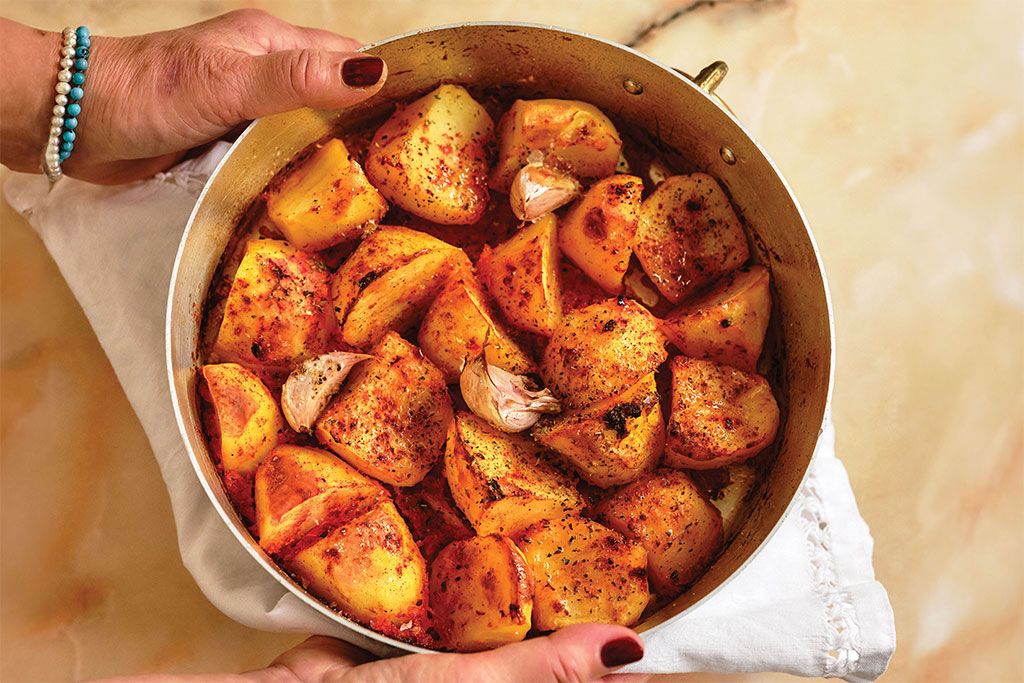
Serves 4–6
Goes with: These moreish potatoes are a treasured favourite and although I can enjoy them on their own, they are also perfect with saucy dishes to soak up the juices or as a side to grilled meats.
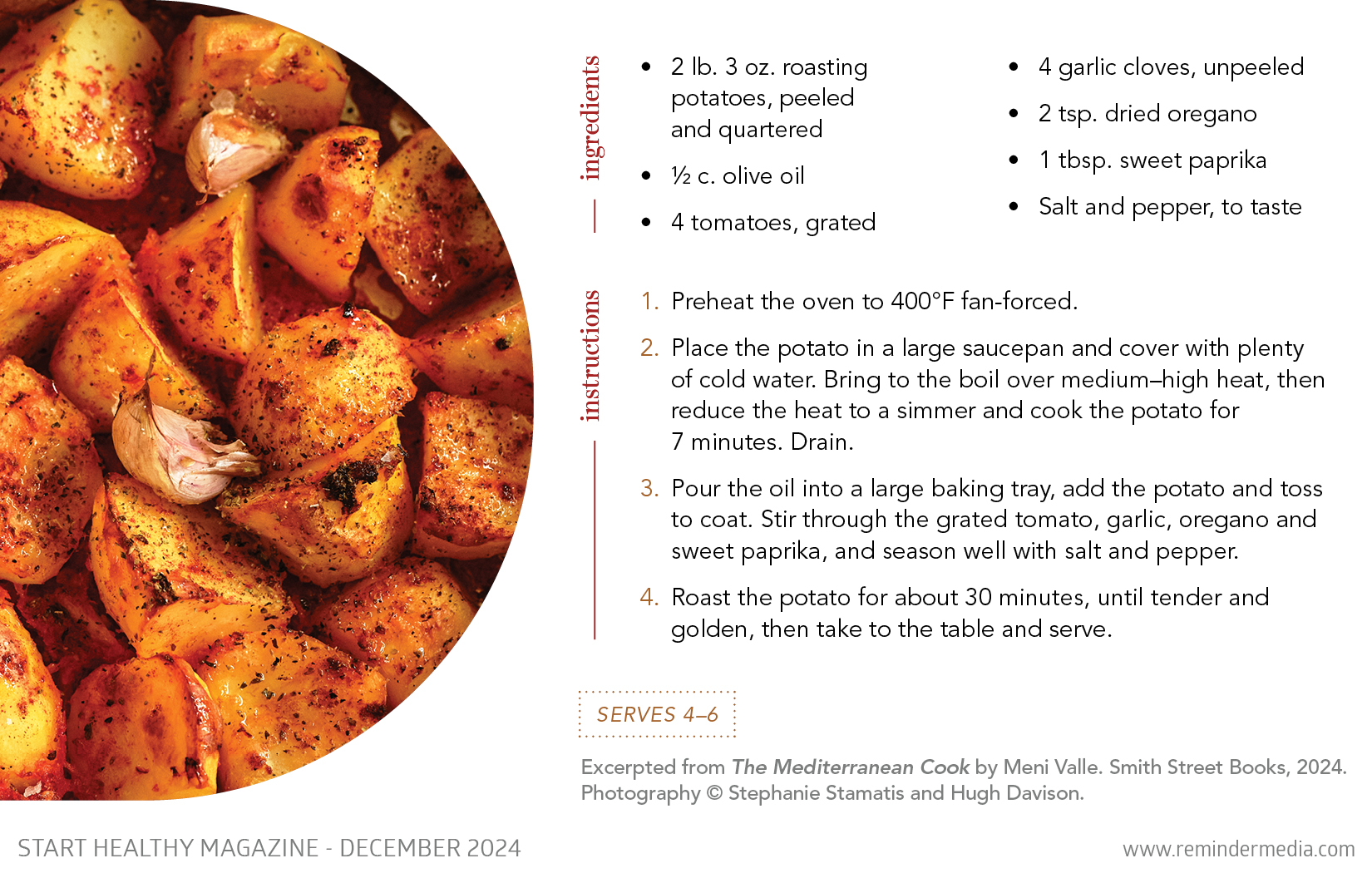

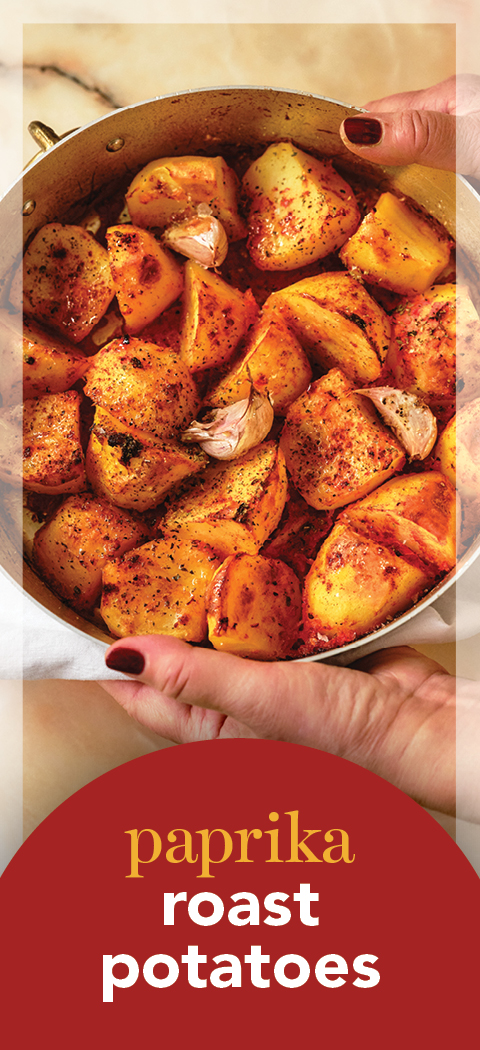
recipe by meni valle
photos by stephanie stamatis and hugh davison
This dish is typically made with pork and is one that my mother made quite often, but I like to make celery the hero . . . its mild, earthy and slightly peppery taste goes so well with the tangy avgolemono sauce. Use the tender leaves as well—most people tend to discard them, but they are lovely.
The delicate avgolemono is mostly known as the sauce for the classic Greek chicken soup of the same name, but it is also luscious as a dressing for dolmades and sarma (stuffed cabbage leaves), as well as a sauce served with roast chicken.

Serves 4–6
Note: If you have excess celery, blanch the stalks in boiling water for a few minutes, then drain and freeze in an airtight container, ready to be added to dishes where it is cooked, such as this one.



The holiday season has arrived, and that means it’s time to break out the board games! This pastime is a staple of festive gatherings with friends and family, and for good reason: it can be an enjoyable way to break the ice, unwind, and encourage people to mingle. But you may be surprised to learn that it can also provide many benefits for your mind and body. Read on to learn more about the health upsides of board games along with some top-tier options to consider trying.

First and foremost, playing a board game provides the perfect opportunity for interactions that form positive bonds, which can go a long way toward improving your overall well-being. Studies show that socially connected individuals tend to be happier, live longer, and have less risk for serious illnesses like heart disease and dementia.
Most games designed for groups can help foster such connections, but some may be especially suited for getting to know one another. The Resistance: Avalon, for instance, promotes conversation and reveals players’ strategic strengths (or weaknesses) as they try to identify which knights are loyal in the kingdom. Or try Mind the Gap, which features trivia from various periods to help bring boomers, Gen Xers, Millennials, and Gen Zers alike closer together.
In addition, board games can encourage the development of beneficial social skills, especially for children; age-appropriate ones like the classic Trouble can teach them how to follow rules and wait their turns. But even adults may strengthen their collaborative abilities through cooperative games. Consider Pandemic, where players must work together to protect the world from disease, or Castle Panic, in which participants fight to keep at least a part of their castle standing against an onslaught of monsters.

When you’re having fun with loved ones, there’s bound to be a lot of laughter, something that can relieve stress to boost your mood and, in the long term, improve your immune system and even mitigate pain. To really take advantage of this benefit, opt for an especially hilarious game like Spontuneous—no one will be able to keep a straight face as players endeavor to be the first to belt a tune containing a selected word. Herd Mentality is another great option that involves everyone trying to come up with answers to questions that fit in with the crowd’s. Who knows just what wacky opinions or habits may be revealed each round?
Even when played solo, board games can banish boredom, a state that can spur more serious conditions like depression and loneliness. So don’t wait until a holiday gathering to pull one out if you’re feeling a bit antsy. Options that support a single player include Alice’s Garden, in which you are tasked with creating a beautiful garden for a queen, and Spirit Island, where your goal is to defend your territory from invading forces.

Among the most popular board games are ones that require careful strategy—such intense engagement is not only fun but can also strengthen the brain and keep it functioning at its best. Though research is still being done on this benefit, it has been found that these games may help improve your focus, memory, decision-making abilities, and more. Chess, checkers, and backgammon are three classics that can offer these upsides, but you can also try the more recent Azul, which involves building horizontal rows of beautifully designed tiles to gain points. Or opt for Pentago, a game similar to Connect 4 but with a twist, to work on your logic and spatial skills.

One of the best ways to protect your brain from the negative benefits of aging is to continually pursue learning. Studies have shown that doing so promotes neuroplasticity to strengthen neural pathways and create new ones, in turn enhancing cognitive skills such as attention to detail. Plus, learning something new can provide a great confidence boost simply from having increased knowledge.
Board games are an ideal avenue for this since you can do it while being entertained. For instance, Wingspan, which involves building and filling a personal aviary, can teach you how to distinguish several species of birds, including by, of course, their wingspans. Trekking the National Parks allows you to “visit” these public spaces and discover more about their features and wildlife. And even those with a black thumb may enjoy growing make-believe houseplants in Planted, where you can get all the essential care details to keeping such greenery alive.
Whether you’re looking to unwind or host a lively game night, playing a board game can be a fantastic option—and you and your loved ones may just reap some extra health benefits along the way.
